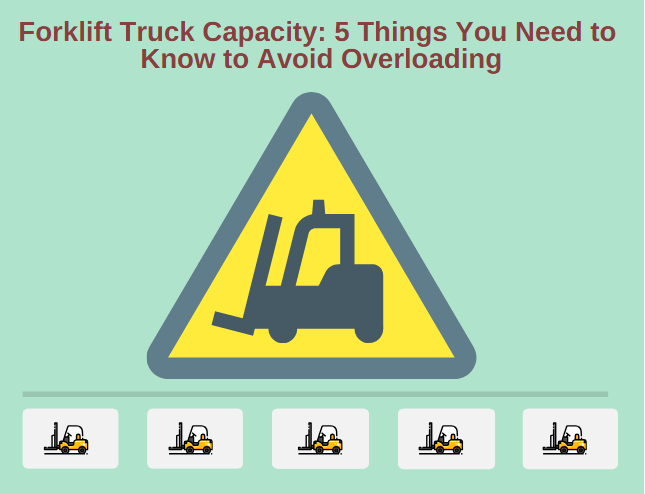In many industrial and commercial settings, forklifts are vital tools that enable the efficient movement of heavy loads. These powerful machines are designed to streamline operations and enhance productivity while minimising the physical toll on workers. However, the effectiveness of forklifts comes with a significant responsibility: ensuring that they’re not overloaded.
Understanding a forklift’s load capacity is essential for maintaining safety in the workplace. Each forklift is engineered with a specific weight limit and exceeding this limit can result in accidents, injuries, and damage to both the forklift and the materials loaded onto it. Thus, understanding the importance of load capacity helps operators make informed decisions, enhancing safety and operational efficiency.
In this article, we will delve into the critical aspects of forklift capacity, offering insights on how to accurately calculate it for different applications.
Determine Each Forklift’s Load Capacity
Each forklift truck is designed with a specific maximum weight it can lift, which is indicated on the data plate that is typically located on the mast or near the operator’s seat. This rating takes into account various factors, including the design and model of the forklift, the stability of the machine, and the intended usage conditions. Operators must familiarise themselves with these specifications before using the equipment to ensure that they’re not exceeding the safe lifting limits.
To avoid misunderstandings, operators should regularly review the capacity ratings and any accompanying documentation provided by the manufacturer. This will help operators make informed decisions that enhance safety, reduce the risk of accidents, and ensure compliance with relevant regulations. This knowledge not only protects the operator but also contributes to the overall safety and efficiency of the workplace.
Weigh the Load Accurately
A forklift operator must know the exact weight of the materials they’re handling to avoid exceeding the forklift’s capacity. Guessing or estimating the weight can easily lead to overloading, which poses serious safety risks. Thus, it’s essential to use a reliable method for weighing loads before they’re lifted.
One effective way to weigh loads is to use calibrated scales. These provide precise measurements and allow operators to make informed decisions about lifting. For large or bulk items that may not fit on a standard scale, alternative methods such as using load cells or weight indicators can also be employed. Additionally, some forklifts come equipped with onboard scales that provide real-time weight readings, further simplifying the weighing process.
In situations where weighing the load is not feasible, operators should refer to the manufacturer’s specifications for common materials and their typical weights. Being familiar with the average weight of frequently handled items can help in making quick, safe decisions. However, this method should not replace actual weighing whenever possible, as variations in material density and packaging can lead to significant discrepancies.
Adjust Capacity for Forklift Attachments
Attachments or accessories like fork extensions, clamps, or rotating forks play a vital role in enhancing the versatility of forklifts, allowing operators to handle a variety of loads more effectively. However, it’s essential to recognise that these attachments can also impact the forklift’s load-bearing capacity. Different attachments can change the centre of gravity of the machine, as well as the weight distribution of the load. As a result, the maximum weight the forklift can lift may be significantly reduced.
Thus, when using attachments, operators must adjust their calculations of the forklift’s lifting capacity to ensure safe operation. Manufacturers typically provide guidelines on how to calculate the revised load capacity when using specific attachments. For guidance, oOperators should refer to the forklift’s data plate or the manufacturer’s documentation.
Additionally, it’s crucial to consider the compatibility of the attachment with the forklift model being used. Not all attachments are suitable for every forklift, and using an incompatible attachment can lead to instability and an increased risk of accidents. Before attaching any accessory, operators should ensure that it’s designed for use with the specific forklift model they are using and that they follow the manufacturer’s instructions for safe usage.
Manage Load Centre for Safe Lifting
Knowing how to manage the load centre is essential for ensuring safe lifting practices and preventing accidents. The load centre refers to the distance from the front of the forks to the point where the weight of the load is evenly distributed. When a load is positioned correctly at the recommended load centre, the forklift operates optimally. If the load is too far from the centre, on the other hand, it can shift the centre of gravity and increase the risk of tipping or losing control.
To ensure safe lifting, operators should always align the load as close to the load centre as possible. This can be achieved by properly positioning the forks before lifting and ensuring that the load is balanced. When stacking materials, it’s also important to distribute the weight evenly across the forks to maintain a stable centre of gravity. Furthermore, operators should take care to avoid tilting the mast excessively when lifting or lowering loads, as this can further compromise stability.
Consider Environmental and Surface Conditions
The environment and surface conditions where a forklift operates significantly impact not just its stability but also its load capacity. Various environmental elements, including weather conditions, terrain type, and surface quality, can impact how a forklift handles loads.
Understanding these factors is essential for ensuring safe lifting practices and preventing accidents in the workplace. First, operators must assess the surface conditions before lifting. Forklifts are designed to operate on smooth, level surfaces; thus, working on inclines or declines should be avoided whenever possible. Similarly, working on unstable surfaces, such as gravel, mud, or damaged concrete, is inadvisable as this can increase the risk of tipping, especially when carrying heavy loads. If operating on such surfaces is unavoidable, caution should be exercised, and operators should be trained to adjust their driving techniques accordingly.
Weather conditions can also play a critical role in outdoor forklift operations. Rain, for instance, can make surfaces slippery, affecting traction and stability. In such conditions, operators should reduce speed, avoid sharp turns, and use caution when lifting and lowering loads. Furthermore, it’s essential to perform pre-operation checks to ensure that the forklift is in proper working order and that safety features, such as brakes and lights, are functioning correctly.
Being aware of the capacity of a forklift, as well as the factors that influence it, is crucial for ensuring safe and efficient operations in a workplace. Implementing these best practices can significantly reduce the risk of accidents and improve overall operational efficiency. With a proactive approach to safety in place, organisations can contribute to a safer working environment.

A dedicated Career Coach, Agile Trainer and certified Senior Portfolio and Project Management Professional and writer holding a bachelor’s degree in Structural Engineering and over 20 years of professional experience in Professional Development / Career Coaching, Portfolio/Program/Project Management, Construction Management, and Business Development. She is the Content Manager of ProjectCubicle.
















Healthcare 360 Magazine aims to transform the global perception and interaction with healthcare by providing a dynamic platform for innovation, expert advice
Mr. Business Magazine is a dynamic and inspirational platform catering to business enthusiasts and leaders worldwide. Personifying the entrepreneurial spirit, it showcases the success stories of global businesses and entrepreneurs.